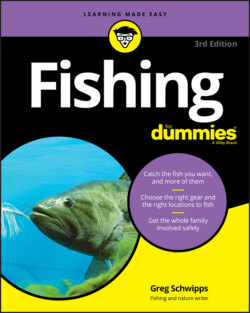Читать книгу Fishing For Dummies - Greg Schwipps - Страница 50
Finding Good Fishing Water
ОглавлениеIN THIS CHAPTER
Finding fishable water you can access
Figuring out the water — and its fish
Seeing the difference between streams and rivers, ponds and lakes
Making saltwater less intimidating
Knowing when to fish
Planning for the weather while fishing
Simply put, every decision I make about how and what I’m fishing for follows the first, crucial decision: where I’m fishing. You don’t fish streams the same way you fish ponds. Big rivers aren’t lakes. Public piers jutting out from the beach aren’t exactly like an untouched tidal inlet. So begin your fishing adventures by studying the body of water you intend to fish. When you know the water, you’ll begin to know the fish in it. And then the fun — the catching — begins!
Wherever you fish, follow the same advice I give college writing students: Pay attention to the world around you. With fishing, this means you must watch the water. Every swirl and splash tells you something. The fish’s world is largely hidden from you, but if you pay attention, you’ll find that every body of water provides hints about what’s happening below the surface. Watch the prey (frogs, minnows, and the like) and fellow predators like birds, and they’ll begin to tell you where the gamefish are.
All fish, in any body of water, relate to two key things: structure and cover. Structure refers to what lies beneath the surface of the body of water; a sharp drop-off or a point (a finger of land jutting into the water) is structure, for example. Think of structure as permanent features. Cover could be things like a weed bed or a sunken log. Manmade cover, like docks or piers, hold fish just as natural cover does. Be aware of structure and cover and you’ll find — and catch — more fish.
This chapter helps you figure out where to fish and then how and when to fish that location. There are a lot of variables at play when it comes to finding and evaluating fishing waters, but I do my best in this chapter to call out some typical conditions for both freshwater and saltwater locations.
